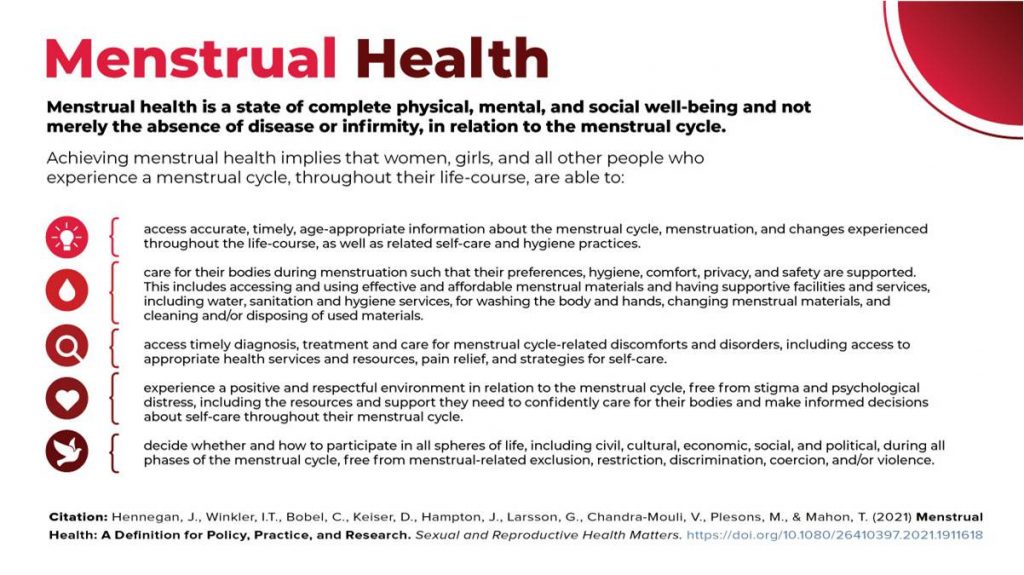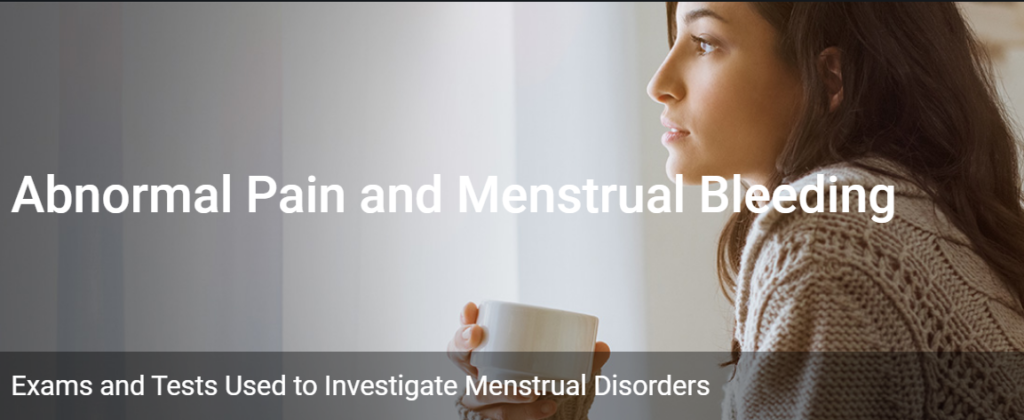


See Book Resources

With each menstrual cycle, the endometrium (uterine lining) prepares itself to nourish a fetus. If fertilization doesn’t occur, the body sheds the endometrium during the monthly (on average) cycle. In some cases, an irregularity can occur in this cycle, indicating any of the following menstrual disorders:

Types of Menstrual Disorders:
1.Premenstrual Syndrome (PMS)
PMS is any unpleasant or uncomfortable symptom during your cycle that may temporarily disturb normal functioning. These symptoms may last from a few hours to many days, and the types and intensity of symptoms can vary in individuals.
PMS Symptoms:
Although each individual may experience symptoms differently, the most common symptoms of PMS can include any of the following:
- Psychological symptoms (depression, anxiety, irritability).
- Gastrointestinal symptoms (bloating).
- Fluid retention (swelling of fingers, ankles and feet).
- Skin problems (acne).
- Headache.
- Vertigo.
- Fainting.
- Muscle spasms.
- Heart palpitations.
- Allergies.
- Infections.
- Vision problems.
- Eye infections.
- Decreased coordination.
- Diminished libido (sex drive).
- Changes in appetite.
- Hot flashes.
Simple modifications in lifestyle can help eliminate or reduce the severity of symptoms, including:
- Exercising 3 to 5 times each week.
- Eating a well-balanced diet that includes whole grains, vegetables and fruit, and a decreasing salt, sugar, caffeine and alcohol intake.
- Getting adequate sleep and rest.
Premenstrual Dysphoric Disorder (PMDD)
Premenstrual Dysphoric Disorder (PMDD) is a much more severe form of PMS which affects approximately 3%-8% of women of reproductive age. PMDD requires treatment by a physician. According to the American College of Obstetricians and Gynaecologists, nearly 85% of women experience at least one common symptom associated with PMS during their reproductive years. An estimated 5% have symptoms so extreme they are disabled by the condition.
Premenstrual Dysphoric Disorder (PMDD) is a more severe form of Premenstrual Syndrome characterized by significant premenstrual mood disturbance, often with prominent mood reactivity and irritability. Symptoms of PMDD can emerge 1-2 weeks preceding menses and typically resolve with the onset of menses. This mood disturbance results in marked social or occupational impairment, with its most prominent effects in interpersonal functioning. In fact, a recent study found that women with untreated PMDD were likely to experience a loss of three quality-adjusted life years during their lifetime as a result of their premenstrual symptoms. This did not include menstruation-free periods, such as pregnancy, breastfeeding and menopause.3
PMDD affects 3-8% of women in their reproductive years, with symptoms usually emerging during a woman’s twenties.2 These symptoms may worsen over time; for example, it has been observed that some women may experience worsening premenstrual symptoms as they enter into menopause.4 Less commonly, PMDD may begin during adolescence, with case reports suggesting that successful treatment options in adolescents with PMDD are similar to those used for adult women.

According to the International Association For Premenstrual Disorders (IAPMD), suicide represents one of the ten leading causes of deaths worldwide among reproductive age women. Studies also show that 30% of women with PMDD will attempt suicide in their lifetime while a larger percentage experience suicidal thoughts and self harm.
The major risk factors for PMDD include personal history of a mood or anxiety disorder, family history of premenstrual mood dysregulation, stress and age in the late 20’s to mid-30’s.
Psychological Symptoms
- Anxiety.
- Feeling overwhelmed or out of control.
- Increased depressed mood.
- Irritability.
- Mood Swings.
- Sense of feeling overwhelmed.
- Sensitivity to rejection.
- Social withdrawal.
- Sudden sadness or tearfulness.
Physical Symptoms
- Abdominal bloating.
- Appetite disturbance (usually increased).
- Breast tenderness.
- Headaches.
- Lethargy or fatigue.
- Muscle aches and/or joint pain.
- Sleep disturbance (usually hypersomnia).
- Swelling of extremities.
Behavioral Symptoms
- Fatigue.
- Forgetfulness.
- Poor Concentration.
It is important for clinicians to distinguish between PMDD and other medical and psychiatric conditions. Medical illnesses such as chronic fatigue syndrome, fibromyalgia, irritable bowel syndrome and migraine disorder can have features that overlap with PMDD. Additionally, psychiatric illnesses such as depression or anxiety disorders can worsen during the premenstrual period and thus may mimic PMDD.
PMS and PMDD in Teens
Epidemiologic studies have shown that premenstrual disorders may begin during the teen years. It has been reported that at least 20% of adolescents experience moderate to severe premenstrual symptoms. PMDD appears to be as common in teens as in older women, with various studies estimating that about 2%-6% of girls between the ages of 14 and 16 meet criteria for PMDD. Randomized controlled trials of pharmacologic treatments have not been conducted in teens with PMS and PMDD; however, clinical experience indicates that the same treatments that are effective for adults may be used in adolescents.
Teens may want to take a look at our Guide for Teens with PMS and PMDD.
Ruling Out Other Psychiatric Illnesses
Mood disorders, such as major depression or bipolar disorder, can worsen during the premenstrual period and thus may mimic PMDD. When this occurs, the term premenstrual exacerbation or PME is used to refer to the mood worsening which occurs during the premenstrual phase. An estimated 40% of women who seek treatment for PMDD actually have a PME of an underlying mood disorder.5
PMDD can be distinguished from other mood disorders primarily by the cyclical nature of the mood disturbance. PMDD mood symptoms are only present for a specific period of time, during the luteal phase (the last two weeks) of the menstrual cycle. Conversely, other mood disorders are variable or constant over time. Therefore, the best way to distinguish PMDD from an underlying mood disorder is through daily charting of symptoms. In addition, PMDD mood symptoms are not present in the absence of a menstrual cycle. Thus, PMDD resolves during pregnancy and after menopause, whereas other mood disorders typically persist across all reproductive life events.
Sourced from PMS & PMDD
2.Amenorrhea
Amenorrhea is characterized by absent menstrual periods for more than three monthly menstrual cycles. There are two types of amenorrhea:
Types of Amenorrhea:
- Primary amenorrhea: Menstruation does not begin at puberty.
- Secondary amenorrhea: Normal and regular menstrual periods which become increasingly abnormal and irregular or absent. This may be due to a physical cause typically of later onset.
Amenorrhea can occur for a number of reasons as part of the normal course of life, such as pregnancy, breast-feeding or menopause. Or, it may occur as a result of medications or a medical problem including:
- Ovulation abnormality.
- Birth defect, anatomical abnormality or other medical condition.
- Eating disorder.
- Obesity.
- Excessive or strenuous exercise.
- Thyroid disorder.
If at least three consecutive menstrual periods are missed or if you’ve never had a menstrual period and are 16 years or older, it is important to see a healthcare professional. As with any condition, early diagnosis and treatment is very important.
3.Dysmenorrhea
Dysmenorrhea is characterized by severe and frequent menstrual cramps and pain associated with menstruation. The cause of dysmenorrhea is dependent on if the condition is primary or secondary. With primary dysmenorrhea, women experience abnormal uterine contractions resulting from a chemical imbalance in the body. Secondary dysmenorrhea is caused by other medical conditions, most often endometriosis. Other possible causes may include:
- pelvic inflammatory disease (PID).
- uterine fibroids.
- abnormal pregnancy (i.e., miscarriage, ectopic).
- infection, tumors, or polyps in the pelvic cavity.
Any woman can develop dysmenorrhea, but those who are at an increased risk include:
- Smokers.
- Those who consume excessive alcohol during their period.
- Women who are overweight.
- Women who started menstruating before the age of 11.
Dysmenorrhea Symptoms.
The most common symptoms may include:
- Cramping or pain in the lower abdomen.
- Low back pain or pain radiating down the legs.
- Nausea.
- Vomiting.
- Diarrhea.
- Fatigue.
- Weakness.
- Fainting.
- Headaches.
Reference; Amenorrhea and Dysmenorrhea : Menstrual Disorders – HealthyWomen
4.Abnormal Uterine bleeding (AUB)
According to the American College of Obstetricians and Gynecologists (ACOG), abnormal uterine bleeding is defined as bleeding from the uterus that is abnormal in regularity, volume, frequency, or duration. The bleeding may be acute or chronic and occurs in non-pregnant women.
AUB is divided into two categories. The first category is heavy menstrual bleeding (HMB), and the other is Intermenstrual bleeding (IMB).
This widely used classification system, known as PALM-COEIN (polyps, adenomyosis, leiomyoma, malignancy; coagulopathy, ovulatory disorders, endometrial, iatrogenic, not yet classified), classifies AUB based on structural versus non-structural causes.
Reference: Abnormal Uterine Bleeding: A Review
Bleeding Categories.
To obtain a better understanding of the classification system, it is important to understand the science behind it. There are three basic components to having a period: the brain, the ovary, and the uterus and all have to work correctly with each other. Below is what can occur when the respective categories do not work well.
Brain Dysfunction
Brain dysfunctions include hypothalamic and pituitary problems.
- Stress, both physical and emotional.
- Inadequate body fat (as in some professional athletes).
- Excess body fat.
- Eating disorders.
- Serious illness of another nature.
- Certain drugs, including some steroids and hormones.
- Other alterations with your endocrine system, such as hyperthyroid disease.
- Brain injury or malformation.
- Primary Unspecified Dysfunction, which is one of the most common causes for anovulation (failure to ovulate) and is frequently not understood.
Ovarian Dysfunction
Some of the reasons an ovary might not ovulate are as follows:
- Abnormally developed ovaries.
- Polycystic ovarian syndrome (also called PCO or PCOS).
- Perimenopause.
- Menopause.
- Ovarian cysts (but not all cysts, not all the time).
- Extensive pelvic adhesions.
- Tumors and cancer.
- Other disorders of the function of the ovarian follicle and corpus luteum.
Uterine Dysfunction
Even when the brain and ovaries are working normally, it is possible for a problem in the uterus to cause abnormal bleeding.
Some of these problems are:
- Polyps.
- Fibroids.
- Adenomyosis.
- Uterine malformation.
- Scars (such as the uterine scar after a C-section).
- Cervical stenosis (narrowing).
- Oral hormones.
Endometriosis and Abnormal Bleeding
Spotlight Panel on Endometriosis
Endometriosis does not itself cause the uterus to bleed abnormally. More specifically, it does not cause the brain, ovary, or uterus to malfunction. However, it does create problems, which can, in turn, affect any of those areas. Therefore, when a woman with endometriosis has abnormal bleeding, indirect effects of the endo have to be ascertained and possible reasons for it.Some examples of abnormal uterine bleeding caused indirectly by endometriosis are:
- Ovarian endometriomas (chocolate cysts) can get large enough to put so much pressure on the rest of the ovary that it is not able to respond to stimulation, or is not able to complete the ovulation process. This then leads to abnormal hormone production and possible bleeding abnormalities.
- Ovaries can become encased by adhesions due to endometriosis. The endo irritates the tissues it’s on, and the adhesion forms as your body attempts to wall off the offending area. When the ovary is entrapped this way, cysts can form and abnormal hormone production can result.
- Many of the medical treatments for endometriosis have as their purpose the modification of your hormones. The response to these drugs is quite variable. Abnormal bleeding is very common with Depo-provera. Lupron, Synarel and Danocrine can all cause abnormal bleeding by interfering with normal ovarian hormone production.
- Hypothalamic-induced abnormalities may occur when the pain of endo causes the patient extreme stress and anxiety. Some patients lose significant amounts of weight because of nausea and other gastrointestinal symptoms.
- Many patients on drug therapy do not get the expected amounts of hormone administration due to malabsorption of the drug from their gastrointestinal tract. Pain, stress, and other medications (especially pain meds, laxatives, and anti-depressants) can affect how well or poorly the drug is absorbed. The entire drug must be properly absorbed for the blood levels to reach the desired state. Poor absorption thus creates inconsistent responses to the therapy.
The end result is that many women with endometriosis do have abnormal bleeding. The doctor must evaluate each patient individually to look for the influence of endometriosis on the above-mentioned factors, and also bleeding that has causes totally independent of the endometriosis.
When all the endometriosis is completely removed, many patients will see their bleeding patterns restored to what is normal for them. Others (whose bleeding problem has nothing to do with endometriosis) may not see change.
It is important to realize that women who have excision often have an interval of abnormal bleeding afterwards. This may be because the manipulator used inside the uterine cavity to move it during surgery can irritate the endometrium. If the ovaries also required surgery, the return to normal function can take 2-3 months. This can also cause an interval of abnormal bleeding post-op.
Information Source:https://centerforendo.com/endo-and-abnormal-bleeding